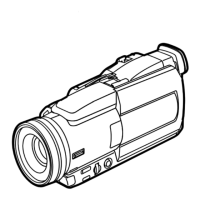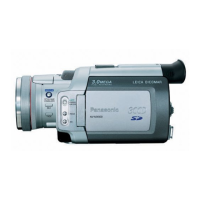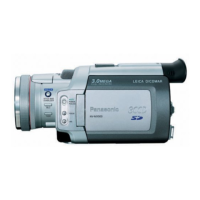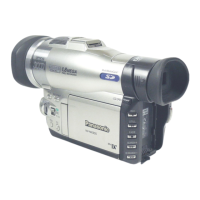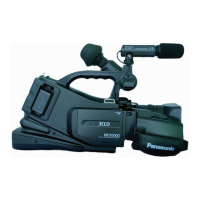Do you have a question about the Panasonic NV-MS4A and is the answer not in the manual?
Provides essential safety information before operating the device.
Highlights copyright laws concerning recorded materials.
Details risks of fire, shock, and proper usage precautions.
Describes the stereo microphone, speaker, and microphone controls.
Details switches for power, S-VHS system, and mode selection.
Explains lens cap, hood, focus ring, and viewfinder adjustments.
Lists sockets for remote control, editing, video, audio, and accessories.
Describes buttons for playback, editing, and tape control.
Explains buttons for digital effects like wipe, mix, and fade.
Explains the S-VHS video system and its advantages.
Details compatibility for recording and playback with VTRs and tapes.
Instructions for charging the battery pack using the AC adapter.
Step-by-step guide for battery pack insertion and removal.
Instructions for connecting and operating the AC adaptor.
Instructions for connecting and operating the car battery cord.
Step-by-step guide to set the camera's internal clock and date.
Explains the internal battery for clock operation and its recharging.
How to display and record date/time information on video.
How to adjust the viewfinder for clear viewing based on eyesight.
How to position the viewfinder for comfortable shooting.
How to return the viewfinder to its default position.
Instructions for cleaning the camera body and lens.
How to adjust the grip belt for comfortable camera handling.
Step-by-step instructions for attaching the shoulder strap.
Step-by-step guide for inserting a video cassette correctly.
Step-by-step guide for ejecting a video cassette safely.
How to break off the tab for record protection.
Instructions to reset the tape counter to '0000'.
How to search for a specific tape position using the counter.
How to make the lap time counter indication appear.
How to hide viewfinder indications using the OSD button.
Explains index signals for VTR search and intro scan functions.
Describes sound recording with the stereo zoom microphone.
How to use the speaker for sound monitoring.
Describes sound selection for audio dubbing.
Proper grip, stance, and eye position for stable shooting.
How to adjust viewfinder for low-angle shooting positions.
Positioning the camera for high-angle shooting.
Methods to achieve more stable pictures during shooting.
Step one for preparing to shoot: attach the battery pack.
Step two: power on the movie camera.
Step three: slide to 'CAMERA' mode.
Step four: insert cassette with intact erasure prevention tab.
Step five: slide to 'ON/AUTO' or 'OFF' for S-VHS system.
Step six: remove the lens cap before shooting.
Step seven: press Start/Stop button to begin shooting.
How to pause and check the last few seconds of recording.
How to search for specific scenes using camera search function.
How to achieve smooth transitions between recorded and new scenes.
How to record a still picture of any desired duration.
Advice to prevent distortion and improve still picture quality.
How to continuously record 6 still images per second.
Advice for combining strobe function with high-speed shutter.
How to perform impressive zoom shots before actual shooting.
How to digitally enlarge subjects up to 100 times.
How to fade in from black for effective scene beginnings.
How to fade out to black for soft scene endings.
How to use the tracer function to emphasize movement speed.
How to use the low light function for better sensitivity.
How to brighten subjects in backlit scenes using iris adjustment.
How to increase sensitivity for shooting in dark conditions.
How to shoot small objects using the close-up function.
Advice for macro shooting, including focus and stability.
How to use high shutter speeds for fast-moving subjects.
How to record automatically after a set delay.
How to record automatically at set intervals.
Explains automatic adjustment for natural color reproduction.
Explains the Kelvin scale and its relation to light source color.
How to manually adjust white balance for a single light source.
How to adjust white balance with multiple or weak light sources.
Explains the automatic focusing on subjects in the center.
Lists scenarios where manual focus is recommended over auto focus.
How to manually focus the camera for precise control.
How to input a still picture into memory for editing.
How to shoot a scene with the still picture inserted via wipe.
How to input a still picture into memory for digital mix.
How to shoot a scene with the still picture superimposed.
How to shoot portraits with a focused face and blurred background.
How iris priority affects depth of field and shutter speed for portraits.
How to play back recorded tapes from the beginning in the viewfinder.
How to stop the playback process.
How to adjust tracking to eliminate noise bars on the picture.
How to rewind or fast-forward the tape in stop mode.
Explains different playback modes like cue, review, and still advance.
How to connect for playback via TV using S-Video input.
Instructions to activate playback on the TV.
How to connect for playback via TV without an AV socket.
How to connect the camera to a VTR for copying.
Steps for performing copying or dubbing between devices.
How to use the edit socket for precise editing.
How to replace recorded pictures with new scenes while keeping original sound.
How to add new sound using the stereo or external microphone.
Explains the built-in VITC generator and its use in editing.
Tips for shooting with VITC for continuous time code.
Explains symptoms and solutions for clogged video heads.
Explains condensation formation and precautions.
General precautions for operating the movie camera safely.
Precautions regarding water, electric fields, and temperature.
Precautions for connecting cables and storing the unit.
Precautions for using, charging, and storing the battery pack and AC adaptor.
Table showing button functionality across different operation modes.
Indicates S-VHS or VHS recording system status.
Shows white balance adjustment status (not made, adjusting, complete).
Indicates when tracer, digital wipe, or digital mix functions are active.
Shows high sensitivity and self-timer/interval recording status.
Displays time, date, battery power, and index signal status.
Displays tape position, elapsed time, and warning/alarm alerts.
Indicates tape running, shooting mode, focus, and zoom status.
Lists common problems, causes, and actions for troubleshooting.
Indicates condensation inside the camera, leading to auto power off.
Indicates that the video heads are clogged and require service.
Shows the battery power level decreasing over time.
Warns of missing cassette or broken tab, preventing shooting.
Indicates the built-in lithium battery for the clock is exhausted.
Indicates tape end and the recording of an index signal.
| Camcorder Media Type | VHS-C |
|---|---|
| Recording System | PAL |
| Optical Zoom | 12x |
| Type | Analog |
| Lens | f/1.6 |
| Viewfinder | Electronic |
| Battery Life | 90 min |


